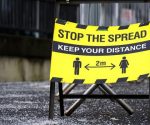The Covid-19 science problem; Part One: for the sake of propaganda, there is no unified understanding of the disease
The Covid-19 narrative has a big problem because the disease can’t satisfy a scientific imperative. Consider the Oxford definition of the word, “science”:
The intellectual and practical activity encompassing the systematic study of the structure and behaviour of the physical and natural world through observation and experiment.
To break this quote down into simple terms, it is saying that science is experience of an object organised in such a way so as to create understanding. Implicit in the definition, then, is how a scientific fact is understanding that is consistent from one iteration of experience to another.
The problem with the disease, Covid-19, is that there isn’t one unified understanding. There is a slender thread of organised experience which produces a variation, and then there is a mass of what is essentially hearsay (a report of evidence) which suggests another. The latter serves the purposes of propaganda and is widely distributed. The former is the real science, and it would break the Covid-19 narrative, but it doesn’t get heard of.
The problem with Covid-19 in terms of science should be self-evident. If thirty-odd thousand in the UK can die of an assortment of various illnesses, and old age, but they have one thing in common, which is an unverifiable diagnosis of Covid-19 (because it was clinical, or obtained by the unreliable PCR test), then how does one classify Covid-19?
What are the mechanics of the illness so that it can kill in all the following cases?:
i) a hospital patient who dies of upper gastrointestinal bleeding;
ii) a sufferer of an incurable cancer who dies of a haemorrhage at home;
iii) a care home resident who has a stroke and dies a few days after;
iv) a hospital patient who dies of an illness of the heart soon after collapsing at home.
Approaching this according to our definition of science, experience teaches the understanding that there are two common factors: a pre-existing illness, and a diagnosis of infection with SARS-COV-2. However, the question must be asked again: given that that the latter component cannot be trusted (as Jon Rappaport satirises it, “doctors and hospitals are putting ‘COVID-19’ on death certificates of 90-year olds falling off buildings and testing positive on the way down”), so the one consistent feature of these deaths is the other circumstances that in themselves could be the root cause, what are the mechanics of Covid-19 that it can kill in all four of the cases?
Very early on in the “pandemic” Covid-19 was classified as a pneumonia caused by a SARS coronavirus, and it was this illness, and complications from it, that killed people. So, having recalled this information, we need to ask if it can help us to understand the mechanics of the deaths in the four cases given above. The short answer is, it can’t, because pneumonia wasn’t a factor in any of them. Indeed, the understanding that one would undoubtedly arrive at when 95% of supposed Covid-19 deaths are inspected is that, in fact, Covid-19 is an irrelevance.
Moreover, people who died of what came to be called Covid-19 pneumonia very likely had complication of flu or a cold, misdiagnosed as Covid-19. As pointed out at the time here at FBEL, the thing about “Covid-19 pneumonia” is that the Covid-19 part could be superfluous.
Be that as it may, it is pneumonia that offers the best lead regarding the nature of Covid-19. The association was inescapable and undeniable for Western medicine because it was translated straight from the Chinese experience. In China, the disease was first called NCIP, or novel coronavirus-infected pneumonia. Now, Western governments may attack the Chinese over their comparatively tiny death toll – 4633 at the time of writing – and claim a conspiracy to cover up, but, in fact, a number for dead in the few thousands is probably par for the course for properly diagnosed Covid-19 cases. The data provided by ICNARC for intensive care numbers in the UK is shaping up along the same lines.
It was practice of the Chinese to use CT scans to observe the lungs for symptoms of Covid-19. What was being sought was particular signs of damage that, presumably, would support a positive PCR test. This is something that has not been repeated in the UK, at least as far as the extensive coverage reveals, and so what we have here is an example, in the UK – as we might well expect- of less rigour, or organisation, in the science as it pertains to applying understanding in new iterations of experience.
Even so, British medical research is aware of what the Chinese knew about Covid-19. It had been discovered that a SARS coronavirus would bind with ACE2 receptors at the lungs, and in doing so create a corruption of matter that would lead to infection, to wit: the pneumonia. If the reader is unfamiliar with this research, then please refer to the FBEL article here (we’re going to revisit the cause of ACE2 proliferation or imbalance in the second part of this series).
It later emerged that SARS-COV-ACE2 binding may be the cause of the low blood oxygen levels that was observed in Covid-19 patients; it was thought that the lung damage was restricting the transfer of oxygen into the blood. Alternatively, the SARS-COV was affecting the levels of hemoglobin. In relation to this symptom, opinion started to emerge that held that using ventilators to treat Covid-19 patients was not only ineffective (because of the lack of capability to disperse oxygen) but also dangerous because of the damage to the lungs by the mechanical operation of the apparatus.
By now it should be eminently clear to the reader that the collective understanding of Covid-19, as briefly examined above, does not account for what we might call the hearsay, or the Rappaport version of the disease: i.e. old people falling and being diagnosed on the way down. Again, this failure of Covid-19 in terms of science is a huge problem.
However, there are people evidently looking for a way to solve this problem, and in fact they do appear to have come up with a bridge that links hearsay Covid-19 with the evidential variety. To introduce this, the reader might as well be presented with an account published by the Daily Mail:
Matt Hancock has ordered health officials to trawl through the records of thousands of pandemic victims to understand why some people are more affected by the disease than others.
The Health Secretary said at the daily news conference on May 4: ‘Emerging data from around the world suggests there could possibly be a relationship between obesity and the impact of Covid-19 on individuals.
‘It’s too early to say if obesity in itself is a factor or conditions associated with it – or there is not enough data yet to rule it out – so we need to approach any assumptions with caution.
‘As part of our continued effort to understand even more about Covid-19, we have commissioned work from Public Health England to consider the impact of various factors such as ethnicity, obesity, age, gender and geographical location and how these may have an impact on someone’s susceptibility to the virus.’
The Government hopes to publish the findings at the end of this month and they will be used to decide whether ‘further action’ should be taken to protect these groups.
The reader might already be aware that there has been an emission of fake science from UK Government regarding racial type and susceptibility to illness, but we can probably dismiss this as divide and conquer as usual. However, the latest threatened offering to bring obesity fully into the mix is not about triggering identity politics related distraction. There is other supporting evidence, to be discussed in the next part of the series, for concluding that we are going to see obesity become a third consistent component in the hearsay version of Covid-19. If we revisit that concept of common factors (introduced at the top of the page), we can predict that they are about to become i) a pre-existing illness, ii) a diagnosis of infection with SARS-COV-2, and iii) obesity in the patient. As well as enabling better congruousness with the evidence based version of Covid-19, this addition will mean that it can be said of the hearsay version that it is the pre-existing illness that is irrelevant, with the pertinent part being the combination of obesity and the SARS-COV-2. The clever part, of course, is the nebulousness of obesity (it’s harmfulness is relative to the individual health terrain), and the fact that the UK Government can utilise what is already an obsession of the NHS’s, and as such is a matter of creed in terms of being considered unhealthy.
In the next part in this series, however, (and as promised) we will realise the astonishing gall of the UK Government and the NHS in blaming obesity, and the mendacity of both in their lining up to utilise as a cure for Covid-19 the very same medicine that is a strong candidate for being culpable for cause in the first place.


















